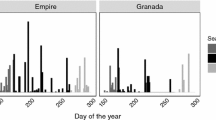Summary
Detailed growth analysis in conjunction with information on leaf display and nitrogen uptake was used to interpret competition between Abutilon theophrasti, a C3 annual, and Amaranthus retroflexus, a C4 annual, under ambient (350 μl l-1) and two levels of elevated (500 and 700 μl l-1) CO2. Plants were grown both individually and in competition with each other. Competition caused a reduction in growth in both species, but for different reasons. In Abutilon, decreases in leaf area ratio (LAR) were responsible, whereas decreased unit leaf rate (ULR) was involved in the case of Amaranthus. Mean canopy height was lower in Amaranthus than Abutilon which may explain the low ULR of Amaranthus in competition. The decrease in LAR of Abutilon was associated with an increase in root/shoot ratio implying that Abutilon was limited by competition for below ground resources. The root/shoot ratio of Amaranthus actually decreased with competition, and Amaranthus had a much higher rate of nitrogen uptake per unit of root than did Abutilon. These latter results suggest that Amaranthus was better able to compete for below ground resources than Abutilon. Although the growth of both species was reduced by competition, generally speaking, the growth of Amaranthus was reduced to a greater extent than that of Abutilon. Regression analysis suggests that the success of Abutilon in competition was due to its larger starting capital (seed size) which gave it an early advantage over Amaranthus. Elevated CO2 had a positive effect upon biomass in Amaranthus, and to a lesser extent, Abutilon. These effects were limited to the early part of the experiment in the case of the individually grown plants, however. Only Amaranthus exhibited a significant increase in relative growth rate (RGR). In spite of the transitory effect of CO2 upon size in individually grown plants, level of CO2 did effect final biomass of competitively grown plants. Abutilon grown in competition with Amaranthus had a greater final biomass than Amaranthus at ambient CO2 levels, but this difference disappeared to a large extent at elevated CO2. The high RGR of Amaranthus at elevated CO2 levels allowed it to overcome the difference in initial size between the two species.
Similar content being viewed by others
References
Bazzaz FA, Carlson RW (1984) The response of plants to elevated CO2. I. Competition among an assemblage of annuals at two levels of soil moisture. Oecologia 62:196–198
Bazzaz FA, Garbutt K (1988) The response of annuals in competitive neighborhoods: Effects of elevated CO2. Ecology (in press)
Björkman O, Pearcy RW (1983) Physiological effects. In: Lemon ER (ed) CO2 and plants: The response of plants to rising levels of atmospheric carbon dioxide. Westview Press, Boulder, CO, pp 65–106
Bremner JM (1965) Inorganic forms of nitrogen. Pages 1179–1273 In: Black CA (ed) Methods of soil analysis. American Society of Agronomy, Madison, Wis. pp 1179–1273
Carlson RW, Bazzaz FA (1980) The effects of elevated CO2 concentrations on growth, photosynthesis, transpiration, and water use efficiency of plants. In: Singh JJ, Deepak A (eds) Environmental and Climatic Impact of Coal Utilization. Academic Press, New York, pp 609–623
Carlson RW, Bazzaz FA (1982) Photosynthetic and growth response to fumigation with SO2 at elevated CO2 for C3 and C4 plants. Oecologia 54:50–54
Carter DR, Peterson KM (1983) Effects of a CO2-enriched atmosphere on the growth and competitive interaction of a C3 and a C4 grass. Oecologia 58:188–193
Gallaher RN, Weldon CO, Boswell FC (1976) A semiautomated procedure for total nitrogen in plant and soil samples. Soil Sci Soc Am J 40:887–889
Hunt R, Parsons IT (1974) A computer program for deriving growth-functions in plant growth analysis. J Appl Ecol 11:297–307
McGraw, JB, Wulff RD (1983) The study of plant growth: A link between physiological ecology and population biology of plants. J Theor Biol 103:21–28
Patterson DT, Flint EP, Beyers JL (1984) Effects of CO2 enrichment on competition between a C4 weed and a C3 crop. Weed Science 32:101–105
Sasek TW, DeLucia EH, Strain BR (1985) Reversibility of photosynthetic inhibition in cotton after long-term exposure to elevated CO2 concentrations. Plant Physiol 78:619–622
Tolley LC, Strain BR (1984a) Effects of CO2 enrichment and water stress on growth of Liquidambar styracifula and Pinus taeda seedlings. Can J Bot 62:2135–2139
Tolley LC, Strain BR (1984b) Effects of CO2 enrichment on growth of Liquidambar styracifula and Pinus taeda seedlings under different irradiance levels. Can J For Res 14:343–350
Tolley LC, Strain BR (1985) Effects of CO2 enrichment and waterstress on gas-exchange of Liquidambar styraciflua and Pinus taeda seedlings grown under different irradiation levels. Oecologia 65:166–172
Zangerl AR, Bazzaz FA (1984) The response of plants to elevated CO2. II. Competitive interactions between annual plants under varying light and nutrients. Oecologia 62:412–417
Author information
Authors and Affiliations
Additional information
This study was supported by a grant from the US Department of Energy
Rights and permissions
About this article
Cite this article
Bazzaz, F.A., Garbutt, K., Reekie, E.G. et al. Using growth analysis to interpret competition between a C3 and a C4 annual under ambient and elevated CO2 . Oecologia 79, 223–235 (1989). https://doi.org/10.1007/BF00388482
Received:
Issue Date:
DOI: https://doi.org/10.1007/BF00388482




